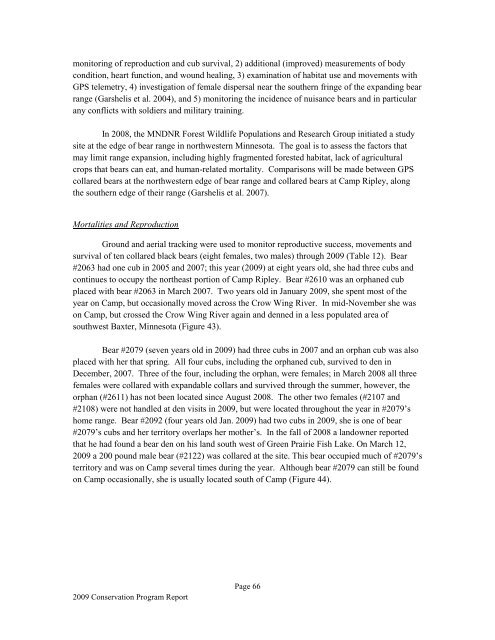camp ripley and arden hills minnesota army national guard training ...
camp ripley and arden hills minnesota army national guard training ...
camp ripley and arden hills minnesota army national guard training ...
You also want an ePaper? Increase the reach of your titles
YUMPU automatically turns print PDFs into web optimized ePapers that Google loves.
monitoring of reproduction <strong>and</strong> cub survival, 2) additional (improved) measurements of body<br />
condition, heart function, <strong>and</strong> wound healing, 3) examination of habitat use <strong>and</strong> movements with<br />
GPS telemetry, 4) investigation of female dispersal near the southern fringe of the exp<strong>and</strong>ing bear<br />
range (Garshelis et al. 2004), <strong>and</strong> 5) monitoring the incidence of nuisance bears <strong>and</strong> in particular<br />
any conflicts with soldiers <strong>and</strong> military <strong>training</strong>.<br />
In 2008, the MNDNR Forest Wildlife Populations <strong>and</strong> Research Group initiated a study<br />
site at the edge of bear range in northwestern Minnesota. The goal is to assess the factors that<br />
may limit range expansion, including highly fragmented forested habitat, lack of agricultural<br />
crops that bears can eat, <strong>and</strong> human-related mortality. Comparisons will be made between GPS<br />
collared bears at the northwestern edge of bear range <strong>and</strong> collared bears at Camp Ripley, along<br />
the southern edge of their range (Garshelis et al. 2007).<br />
Mortalities <strong>and</strong> Reproduction<br />
Ground <strong>and</strong> aerial tracking were used to monitor reproductive success, movements <strong>and</strong><br />
survival of ten collared black bears (eight females, two males) through 2009 (Table 12). Bear<br />
#2063 had one cub in 2005 <strong>and</strong> 2007; this year (2009) at eight years old, she had three cubs <strong>and</strong><br />
continues to occupy the northeast portion of Camp Ripley. Bear #2610 was an orphaned cub<br />
placed with bear #2063 in March 2007. Two years old in January 2009, she spent most of the<br />
year on Camp, but occasionally moved across the Crow Wing River. In mid-November she was<br />
on Camp, but crossed the Crow Wing River again <strong>and</strong> denned in a less populated area of<br />
southwest Baxter, Minnesota (Figure 43).<br />
Bear #2079 (seven years old in 2009) had three cubs in 2007 <strong>and</strong> an orphan cub was also<br />
placed with her that spring. All four cubs, including the orphaned cub, survived to den in<br />
December, 2007. Three of the four, including the orphan, were females; in March 2008 all three<br />
females were collared with exp<strong>and</strong>able collars <strong>and</strong> survived through the summer, however, the<br />
orphan (#2611) has not been located since August 2008. The other two females (#2107 <strong>and</strong><br />
#2108) were not h<strong>and</strong>led at den visits in 2009, but were located throughout the year in #2079‟s<br />
home range. Bear #2092 (four years old Jan. 2009) had two cubs in 2009, she is one of bear<br />
#2079‟s cubs <strong>and</strong> her territory overlaps her mother‟s. In the fall of 2008 a l<strong>and</strong>owner reported<br />
that he had found a bear den on his l<strong>and</strong> south west of Green Prairie Fish Lake. On March 12,<br />
2009 a 200 pound male bear (#2122) was collared at the site. This bear occupied much of #2079‟s<br />
territory <strong>and</strong> was on Camp several times during the year. Although bear #2079 can still be found<br />
on Camp occasionally, she is usually located south of Camp (Figure 44).<br />
2009 Conservation Program Report<br />
Page 66
















